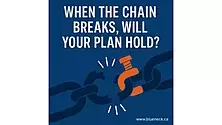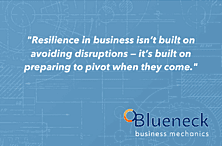The Leader's Quest: A World in Flux
Episode 4: Navigating the Unknown: Charting a Path Through Adversity
Article 2: Supply Chain Maze: Building Contingency Plans


Supply Chain Snarls: Are You Ready?
Supply chain disruptions aren’t just a temporary problem — they’re a daily operational risk for small and midsize businesses. From delayed materials and price hikes to unfulfilled orders and frustrated clients, one broken link can throw your entire operation off track.
Imagine this: You're a small Canadian construction firm gearing up for a major project. You've booked the crew, prepped the location, and the client is counting down. Then —bam — your key materials are delayed. Not for the first time either! A port strike drags into its third week, and your backup supplier just hiked prices due to exchange rate swings.
Have you ever faced something like this?
These aren’t one-off surprises anymore, they’re the new normal. Many small businesses are navigating the same storm.
This week, we're diving into how businesses can build practical contingency plans to prepare for — and bounce back from — supply chain shocks. Whether you rely on international freight or local suppliers, the time to plan for disruptions is before they hit.
Click on the right/left arrows to read the rest of the article.

When the Chain Breaks: Plans Matter
Global instability — political tensions, climate events, currency fluctuations, or labor disputes — can throw even the most reliable supply chain into chaos. For smaller businesses, the fallout can feel fast, direct and personal. Here’s what we’re seeing:
- Long lead times bring projects and production to a standstill
- Sudden price hikes eat into already slim margins
- Inventory shortages lead to lost orders and customers
- Missed deadlines damage your brand and reputation
- Staff downtime increases when key materials don’t arrive on time
Yet many small businesses still operate without a Plan B — hoping “this time it’ll hold.”
But hope isn’t a strategy. Resilience is.
That means knowing your risks, testing alternatives, and building systems that flex when pressured.
Here’s the good news: contingency planning doesn’t have to be complicated to be effective. With a clear process and the right tools, small businesses can future-proof their operations and keep moving — even when global chaos knocks at the door.
Click on the right/left arrows to read the rest of the article.

Reflection: Spot the Weak Links
If you want to weather disruption, start by understanding your current exposure. Use these questions to identify your current vulnerabilities and where to strengthen your operations:
- Supplier Dependency: Do you rely on a single supplier for critical materials?
- Lead Time Visibility: How well can you track delivery times — and what’s your buffer time?
- Backup Readiness: Do you have backup suppliers you trust and can activate quickly?
- Communication Systems: Can you quickly alert your team & customers when supply chain delays occur?
- Cash Flow Flexibility: Can your finances absorb sudden supply cost increases?
Resilient businesses ask these questions early — before crisis hits. Reflecting now helps you prepare smarter, act faster, and avoid costly downtime later.
Click on the right/left arrows to read the rest of the article.

Today’s Actions, Tomorrow’s Continuity
You don’t need to overhaul your business to build resilience, you just need to start. These quick actions can help reduce risk, protect revenue, and give your team breathing room this month:
- Review: Revisit your top 5 critical products. Where are the likely points of supply failure?
- Document: Create a “supply risk map” outlining who supplies what and identify delivery lead times.
- Reach Out: Contact at least one alternate supplier and request a quote or trial order.
- Communicate: Draft re-useable messages to keep customers informed of delays.
- Train: Make sure your team knows what do — and their role in the plan.
These small actions create big resilience. It’s not about doing everything — just taking intentional, proactive steps toward stability.
Click on the right/left arrows to read the rest of the article.

Longer Solutions: Turn Chaos into Continuity
Once you’ve addressed the basics, it’s time to build a more robust system. These five strategies can help you create a supply chain that’s agile, dependable, and disruption-ready:
- Map Your Supply Chain
Understand every tier from raw materials to logistics. Include everyone in the chain that can impact your supply.
💡Tip: Use a simple flowchart to identify dependencies and bottlenecks. - Vet Backup Suppliers
Build trusted relationships with alternate suppliers who use different sources and supply chains before you're in crisis mode – quality and trust take time.
💡Tip: Request small test orders now to evaluate speed, quality, and pricing. - Strengthen Inventory Forecasting
Use your historical sales data, current growth plans, and seasonal trends to better plan and prevent gaps.
💡Tip: Add buffer stock for your highest revenue items during high-risk periods. - Scenario Plan with Your Team
Ask your team “what if” questions: What happens if lead times double? If a key supplier shuts down?
💡Tip: Assign response roles before problems arise — don’t wait until you're in the thick of it. - Create Communication Systems
Transparency builds trust — especially when things go wrong.
💡Tip: Create a ready-to-use email and phone script for disruption updates.
Building a resilient supply chain isn’t just about sourcing — it’s about people, systems, and speed. These strategies help you respond with clarity instead of scrambling in crisis.
Click on the right/left arrows to read the rest of the article.


Resilience Isn’t Optional — It’s Operational
In today’s unpredictable environment, supply chain disruptions are no longer “if”— they’re “when.” The businesses that thrive aren’t the ones with perfect systems — they’re the ones that plan to pivot.
What would happen to your business if your top supplier fell through tomorrow?
Would you stall — or shift?
Resilient businesses don’t leave success to chance. They prepare, adapt, and keep moving forward — no matter what comes their way. Supply chain disruptions may be out of your control, but your response never is. Blueneck can help you turn disruption into direction. Let’s for a complimentary strategy session.
NOTE: Operational resilience is only half the equation. When disruptions hit, your team looks to you for direction. Pair your contingency plans with strong leadership strategies — watch for our companion article which will be posted on Friday, “How to Build Resilient Leaders in a High-Change Environment”. This information aims to strengthen your ability to lead through uncertainty with clarity and calm.
Episode 4: Navigating the Unknown
No one should climb a rope without knowing it will hold and the same goes for new business ideas. In next week’s article, we’ll explore how pilot programs can help you test, tweak, and implement change faster, with lower risk and greater impact.
Small wins build momentum. Small failures build wisdom. We’ll show you how to harness both. Stay tuned.
Read More Articles
As 2025 progresses, we will be unveiling 45 unique articles to help leaders unlock opportunities in an uncertain world!

